実施日 : 2011年07月06日(水) - 07日(木)
Notice: Kyushu Press Tour (Fukuoka City/APU) (July 6-7, 2011)
投稿日 : 2013年08月22日
Vibrant Kyushu, Recovering from “Damage by Rumor”
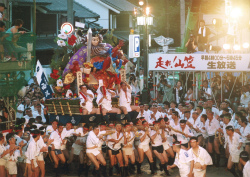 After the earthquake disaster on March 11 and the resultant accident at Fukushima Daiichi Nuclear Power Plant, even the Kyushu region, which is more than 1,000 km away from the Tohoku region, suffered an 80 to 90 % decrease in foreign tourists, influenced by the rumor, “the whole of Japan is dangerous.”
After the earthquake disaster on March 11 and the resultant accident at Fukushima Daiichi Nuclear Power Plant, even the Kyushu region, which is more than 1,000 km away from the Tohoku region, suffered an 80 to 90 % decrease in foreign tourists, influenced by the rumor, “the whole of Japan is dangerous.”
Kyushu (plus Yamaguchi prefecture) received about 1 million foreign visitors in 2010. Many were from China, Korea and Taiwan. Because of its closeness and easy accessibility to other East Asian countries, Kyushu had long been a popular destination for Asian tourists. Therefore, the drastic drop in foreign tourists has had a negative impact on the local economy.
However, three months after the earthquake (*at the time of the press tour, it will be close to four months), the number of foreign tourists is now gradually recovering and the region is getting its vibrancy back again. A Chinese cruise ship's regular call at the Port of Hakata (Fukuoka City), which stopped after the disaster, is scheduled to resume in August.
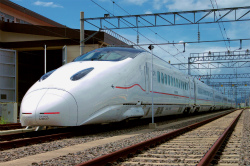
On March 12,the Kyushu Shinkansen express train, which runs down through the whole of Kyushu Island connecting Fukuoka to Kagoshima, was fully opened, and has been revitalizing the region. This new opening means that 2,400 km of the Japanese archipelago, from Aomori in the north to Kagoshima in the south, is now covered by Shinkansen lines. Since the earthquake, Fukuoka City is gaining more and more attention from private companies, notably those in the IT industry, which are aiming to decentralize their bases or functions in order to spread the risk.
Ritsumeikan Asia Pacific University (APU) located in Beppu City, Oita Prefecture, has 2,692 foreign students, almost half of its total number of 5,980. After the disaster, a students’ group including students from overseas provided videos with disaster-related information in 12 languages through the Internet. They have also translated the latest low levels of radiation in Oita Prefecture announced every day in Japanese by the Prefectural government, into English and promptly offered the information on their website.
The tour will visit Fukuoka city, especially lively in the festival period of the Hakata Gion Yamakasa, Ritsumeikan Asia Pacific University (APU), and the town of Kannawa Onsen (hot spring) in Beppu City, the location of APU.
Presentations
1. Interview with Mayor of Fukuoka City
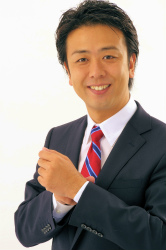 Fukuoka City, the main city of Kyushu Island, has been historically developed as an emporium exchanging with Asian countries, benefitting from its closeness. Fukuoka Airport, an international airport reached by a mere 5-minute subway ride from the city center, and the Port of Hakata, the largest passenger port in Japan, are strong advantages of the city. The number of foreign visitors to Fukuoka City in 2010 was more than 760,000, counting only those entering Fukuoka Airport and the Port of Hakata. Many of those visitors were from East Asia, especially Korea, China and Taiwan. Fukuoka is truly Japan’s gateway for Asian countries. After the disaster on March 11, the Mayor of Fukuoka City, Mr. Soichiro Takashima, announced his message to the world: Western Japan, including Kyushu Island, has not experienced any direct damage. We are maintaining normal day-to-day and economic activities in order to take all possible measures to provide support to the affected areas. I strongly believe that enhanced trade activities and welcoming visitors will assist in Japan’s recovery.
Fukuoka City, the main city of Kyushu Island, has been historically developed as an emporium exchanging with Asian countries, benefitting from its closeness. Fukuoka Airport, an international airport reached by a mere 5-minute subway ride from the city center, and the Port of Hakata, the largest passenger port in Japan, are strong advantages of the city. The number of foreign visitors to Fukuoka City in 2010 was more than 760,000, counting only those entering Fukuoka Airport and the Port of Hakata. Many of those visitors were from East Asia, especially Korea, China and Taiwan. Fukuoka is truly Japan’s gateway for Asian countries. After the disaster on March 11, the Mayor of Fukuoka City, Mr. Soichiro Takashima, announced his message to the world: Western Japan, including Kyushu Island, has not experienced any direct damage. We are maintaining normal day-to-day and economic activities in order to take all possible measures to provide support to the affected areas. I strongly believe that enhanced trade activities and welcoming visitors will assist in Japan’s recovery.
The tour will feature an interview with the Mayor, asking about the effect of the rumors caused by the disaster, how the city has been dealing with them, and how matters are today. The tour will also hear his vision of the city in terms of the full opening of the Kyushu Shinkansen, attracting new enterprises, and the role of the city in the Asian region.
2. Kyushu Shinkansen, Kyushu Railway Company (JR Kyushu)

The Kyushu Shinkansen line fully opened on 12 March 2011; after 37 years since the planning, at last the Kyushu Shinkansen connects Fukuoka to Kagoshima, 257km across Kyushu Island, in a minimum of 1 hour and 19 minutes with the newly opened line between Hakata (Fukuoka prefecture) to Shin-Yatsushiro (Kumamoto prefecture) linking up with the line between Shin-Yatsushiro and Kagoshima-Chuo (Kagoshima prefecture) which had already been operating. Locals have high expectations for it even though its opening day, unfortunately the day after the quake, was rather quiet. The outstanding design of the coaches, typical for JR Kyushu, is attracting huge attention. Local wood and Japanese-inspired decoration is used. Showing off the culture in the cabin design of the Shinkansen is something unique to Kyushu. They have also made efforts to attract foreign tourists by having recorded announcements in four languages: Japanese, English, Chinese and Korean. With this complete opening of the Kyushu line, the Shinkansen now runs from the north of Japan (Aomori) to the south of Japan (Kagoshima), a total distance of about 2,400 km. It should be noted that on March 11 when the earthquake occurred, the Tohoku Shinkansen in the area slowed down automatically when it detected the initial shake, and this prevented a serious accident. The Kyushu Shinkansen has the same anti-quake system.
In this tour, we will board a Kyushu Shinkansen and have a briefing on its anti-quake system by JR Kyushu officials.
3. Hakata Gion Yamakasa; a Shinto ritual, Goshin Ire by Nishi nagare
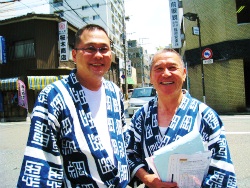
Fukuoka’s summer cannot start without Hakata Gion Yamakasa, a rite dating back to the Kamakura period, and celebrating its 770-years anniversary in 2011. Back In 1241, the middle of the Kamakura period, the villagers carried around a noted monk named Shoichi Kokushi on a shelf normally used for offerings, sprinkling holy water to cure an epidemic. That is said to be how it started. It is astonishing to see groups of men carrying “Yamakasa,” huge decorated floats, around the town. They are also designated as Important Intangible Folk Cultural Properties. Despite the widespread cancellation of festivals and events in the Kanto region due to the attitude of “self-restraint” and the shortage of security guards in the current situation, the Hakata Gion Yamakasa is being held as usual, filling the entire city with excitement. Each of the seven boroughs of the Hakata district of Fukuoka City, called “nagare,” makes its own float and races it. Mr. Kyutaro Kinashi, the head of the “Nishi nagare” says, “We hope to cheer up the people in the disaster-affected areas in East Japan and give them encouragement for recovery.”
Just a week before they start racing the Yamakasa, the tour will visit the solemn scene of Goshin Ire, the Shinto ritual of purifying the Yamakasa, of the Nishi nagare, and will also have a briefing by Mr. Toshio Kamo, the deputy head of the Nishi nagare.
4. Trend of Corporate Risk Diversification Making Fukuoka More Attractive / Polyphony Digital Inc.
- More companies are moving their offices to Fukuoka
After the earthquake on March 11, some private companies, mainly IT businesses, started moving toward diversification of their overconcentrated offices and functions, as a form of risk management. One popular destination is Fukuoka City, since it is close to Asia and has a good living environment. The Fukuoka Municipal Government also provides companies moving to the city with financial support by bearing one-third of the office rent in the first year. After the earthquake, nearly 40 companies asked for information on moving their offices to Fukuoka, and about seven companies have already decided to come to the city.

Polyphony Digital Inc., a 100% subsidiary of Sony Computer Entertainment Inc., is a software developer which produces computer games particularly about cars and motorbikes. Its major hit is the “Gran Turismo” series for PlayStation, with world cumulative sales of 63.15 million units. The company moved part of their head office functions to Fukuoka City in June.
In this press tour, the International Economic Affairs Department of Fukuoka City will give a briefing on the companies moving their offices to the city. You will also visit Polyphony Digital Inc. and hear what is behind their decision to move here.
5. Ippudo (Chikaranomoto Company Co., Ltd.)
Fukuoka is known for its unique food culture, including mentaiko (spicy cod roe), and motsunabe (offal hot pot), and probably the most popular local cuisine, tonkotsu (pork based) ramen noodles. Ippudo noodle restaurant, based in Fukuoka, is now trying to spread tonkotsu ramen to the rest of the world. The company opened a restaurant in New York in 2008, hoping to make ramen, “soul food” for the Japanese, into an internationally popular food. The restaurant in New York is now such a big success that you have to wait for an hour in a long line before actually tasting the noodles. They have also made their debut in Singapore and South Korea, and are now planning to make inroads into China and Hong Kong this year, opening 80 restaurants in five years. To enable people outside of Japan to enjoy real ramen, they use local ingredients while maintaining the real Fukuoka taste.
The press tour will visit Ippudo, where you will have tonkotsu ramen for lunch and have a briefing from the company.
*If you are not able to eat tonkotsu ramen, we will arrange for other food.
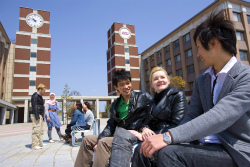
6. Ritsumeikan Asia Pacific University (APU) (Beppu City, Oita Prefecture)
Ritsumeikan Asia Pacific University (APU) is one of the leading universities in Japan in terms of the number of international students. Of the total 5980 students, 2692 are non-Japanese from over 120 countries and regions, making the campus multicultural. In this press tour, you will have a chance to interview President Shun Korenaga and cover various activities of the international students.
- Student Press Assistant (SPA)
APU’s “Student Press Assistant (SPA)” is a group of students including international students, who provide information on the attractive features of the university in and out of Japan. Since the earthquake on March 11, they have posted 12-language videos on YouTube, and provided accurate information on the post-earthquake situation to anxious foreign students and their parents. Students from various countries/regions translated information on radioactive materials in Oita Prefecture, released by the prefectural government, into their mother tongues. They have also explained, using charts, about airborne radiation levels and radioactive materials in the tap-water, which are available only in Japanese on the website of Oita Prefecture. The website of Student Press Assistant provides information in English and Japanese on radiation levels released by the prefectural government every day.
- Indonesia Week
Multicultural Week is an APU symbolic event, held in spring and fall. Each week during the event, cultural events of a specific country/region are held, and students from that country/region organize the whole event, including planning, fund-raising from companies and embassies of their own country, and management. Various cultural performances and exhibitions will be held on the campus and traditional food will be also served in the cafeteria. The grand show on the last night (Friday) attracts a large audience even from outside of Oita Prefecture, with some standees. The day of this press tour is in the middle of Indonesia Week. “We would like students from all over the world and people in this region to know more about Indonesia,” enthusiastically said Mr. Muhammad Mustafainal Akhyar, who has been working on the event for the past six months.
- Mr. LU Fan, an APU Graduate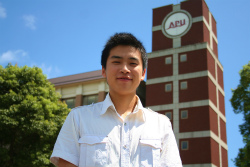 Mr. Lu Fan from Shandong, China, graduated from APU in 2009 and took a job at a local travel agency near APU in Beppu City. He has been engaged in receiving tourists from Asian countries such as China. Having been conducting friendship activities between Japan and China since his university days, he decided to work for a local travel agent to “return a favor to Beppu.” He aims to “become ‘a step ladder’ between the two countries, rather than a bridge.” The distant disaster brought serious damage to Beppu too and the number of tourists declined. However he sees the strong possibilities of Beppu with great attractions such as therapeutic treatments and advanced medical care which Chinese people are looking for.
Mr. Lu Fan from Shandong, China, graduated from APU in 2009 and took a job at a local travel agency near APU in Beppu City. He has been engaged in receiving tourists from Asian countries such as China. Having been conducting friendship activities between Japan and China since his university days, he decided to work for a local travel agent to “return a favor to Beppu.” He aims to “become ‘a step ladder’ between the two countries, rather than a bridge.” The distant disaster brought serious damage to Beppu too and the number of tourists declined. However he sees the strong possibilities of Beppu with great attractions such as therapeutic treatments and advanced medical care which Chinese people are looking for.
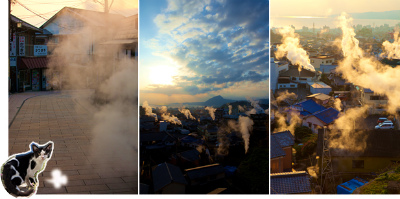
7. Town of Kanawa Onsen (Hot Spring) (Beppu City, Oita Prefecture)
APU is located in Beppu City which is a hot spring district with a great amount of natural hot water, the largest in Japan and the second largest in the world. The Kannawa Onsen, neighboring APU, has the largest number of hot springs in Beppu City. It is believed that the Kannawa Onsen’s origin was a therapeutic bath opened by Ippen Shonin (a Japanese Buddhist preacher) who visited there in the Kamakura Period (AC 1185-1333). There are many long-stay visitors receiving treatment in the town which has developed into a traditional therapeutic spa. Recently, the Kannawa Onsen has also become popular among Asian tourists. In Beppu City including the Kannawa Onsen, hotels and inns handle foreign exchange such as South Korean Won, Taiwan Dollar, Hong Kong Dollar, Chinese Renminbi, Euro and US Dollar. In 2009, these accommodations in Beppu also started allowing people to pay their bills in South Korean Won, as the first systematic example in Japan. The key person of these movements is Mr. Kenichi Kai, Chairperson of the Foreign Tourists Welcoming Committee of Beppu City. “Accepting the currency of the customer’s country is an important way of showing hospitality as an international tourist city,” says Mr. Kai, who has also been appointed a “Visit Japan Ambassador” by the Japan Tourism Agency. He provides walking tours in the town, introducing the charm of the Kannawa Onsen. Besides him and other local volunteers, some past APU students have joined the project and offered tours in several languages.
Beppu City including the Kannawa Onsen, hotels and inns handle foreign exchange such as South Korean Won, Taiwan Dollar, Hong Kong Dollar, Chinese Renminbi, Euro and US Dollar. In 2009, these accommodations in Beppu also started allowing people to pay their bills in South Korean Won, as the first systematic example in Japan. The key person of these movements is Mr. Kenichi Kai, Chairperson of the Foreign Tourists Welcoming Committee of Beppu City. “Accepting the currency of the customer’s country is an important way of showing hospitality as an international tourist city,” says Mr. Kai, who has also been appointed a “Visit Japan Ambassador” by the Japan Tourism Agency. He provides walking tours in the town, introducing the charm of the Kannawa Onsen. Besides him and other local volunteers, some past APU students have joined the project and offered tours in several languages.
The tour will have an interview with Mr. Kai and a walk around the classical and atmospheric streets which attract tourists from both home and abroad.
Tour Itinerary and Application Details
1. Tour itinerary (tentative):
*Detailed information was sent to each participant.
Day 1: Wednesday, July 6
Meet at Haneda Airport Terminal 2 (2nd floor in front of clock tower no. 1) by 6:50 a.m.
Day 2: Thursday, July 7
2. Qualification:
Participants must have Gaimusho Foreign Press Registration Cards
3. Cost:
13,000 yen per person including transportation, meals and accommodation
*FPCJ will inform the participants of payment methods, cancellation fee etc. later on.
4. Participants:
Limited to the first 10 applicants on a first-come-first-served basis. (Only one reporter and one photographer from each organization, but two participants from each TV team will be acceptable.) If the number of applicants exceeds 10, an upper limit may be set on the number of participants from each country.
5. FPCJ Contact:
Ms. Chika Yoshida / Mr. Yano (Tel: 03-3501-3405)
6. Remarks:
1) There may be some restrictions on photographing and filming in the press tour. Please follow the instructions of the officials on duty.
2) FPCJ will not be liable for any inconvenience, trouble or accident that might occur in the course of the tour.


